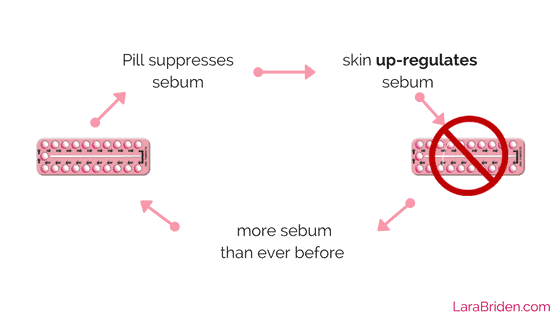 Coming off birth control doesn’t have to be a nightmare for skin. Your skin might have been bad the last time you tried to stop the pill but this time will be different. This time, you’ll know about post-pill acne and how to treat it.
Coming off birth control doesn’t have to be a nightmare for skin. Your skin might have been bad the last time you tried to stop the pill but this time will be different. This time, you’ll know about post-pill acne and how to treat it.
What causes post-pill acne?
Certain types of hormonal birth control suppress sebum (skin oils) to “childhood levels,” which is a bit frightening when you think about it. Adults are supposed to have more sebum than children, so it’s an abnormal situation. Your skin responds by up-regulating sebum, and that upregulation can persist for months even after you stop the pill (see the diagram).

Post-pill acne is the result of:
- rebound sebum production as you withdraw from the sebum-suppressing drugs drospirenone (Yasmin) or cyproterone (Brenda or Diane), or
- a temporary surge in androgens (male hormones) as your ovaries kick back into action, during which time you could be mistakenly diagnosed with PCOS.
The withdrawal process won’t last forever, but it could last up to a year or more. And post-pill acne usually peaks about six months off the pill—just when you were about to give up hope.

Don’t give up hope! You’ll eventually get through the drug withdrawal process.
Natural treatment of post-pill acne
For best results, start treatment a couple of months before you stop the pill. That way, your skin will be less reactive and better able to withdraw from the drugs.
- Avoid normal A1 cow’s dairy because it spikes a hormone called IGF-1 and because it contains an inflammatory protein called A1 casein which can stimulate mast cells and histamine. Avoid all normal dairy (yogurt, cheese, ice cream, milky coffees), but you can have butter (which has almost no casein) and goat or sheep dairy (which has only A2 casein).
- Reduce sugar because (like dairy) it spikes IGF-1. Sugar is the high-dose fructose you get from desserts, honey, fruit juice, and dried fruit, not the low-dose fructose you get from whole fruit. Read my blog post about high-dose fructose.
- Take zinc. Zinc is the perfect medicine for post-pill acne because it reduces keratin, kills bacteria and reduces testosterone. Read 7 ways zinc rescues hormones, and remember, you’ll probably need at least 30 mg of good quality zinc, such as a liquid.
- Consider taking DIM (diindolylmethane), which is a phytonutrient from broccoli. DIM is a natural androgen blocker and is one of the most popular natural treatments for acne.
- Consider taking the herbal medicine berberine, which is antimicrobial, anti-inflammatory, and improves insulin sensitivity (thereby reducing the acne hormone IGF-1). Berberine also reduces androgens in women, which makes it a particularly good choice for PCOS. Berberine is not safe if you’re pregnant or breastfeeding and can interfere with some prescription medications. Speak to your clinician or pharmacist for more information about how to use berberine safely.
- Support healthy stomach acid with gentian or betaine hydrochloride (HCL). Forty percent of people with acne have low stomach acid.
How long till your skin improves?
Some degree of improvement can occur in the first few weeks from the immediate effect of reducing histamine and inflammation. Lasting improvement will take at least six months.
Ask me in the comments.
